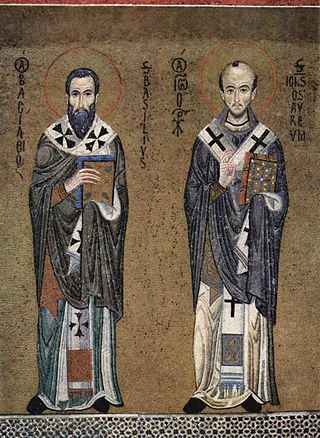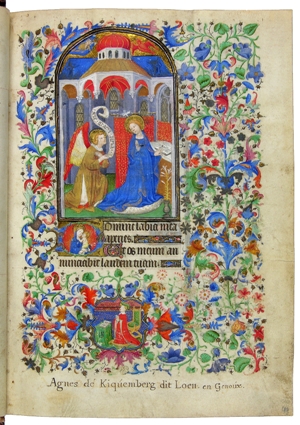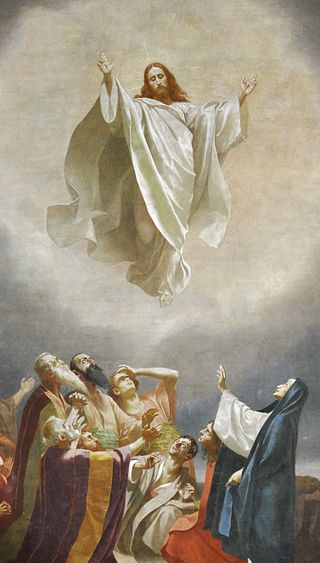
All Souls' Day, also called The Commemoration of All the Faithful Departed, is a day of prayer and remembrance for the faithful departed, observed by certain Christian denominations on 2 November. Through prayer, intercessions, alms and visits to cemeteries, people commemorate the poor souls in purgatory and gain them indulgences.

Great Lent, or the Great Fast, is the most important fasting season of the church year within many denominations of Eastern Christianity. It is intended to prepare Christians for the greatest feast of the church year, Pascha (Easter).

The liturgical year, also called the church year, Christian year or kalendar, consists of the cycle of liturgical seasons in Christian churches that determines when feast days, including celebrations of saints, are to be observed, and which portions of Scripture are to be read either in an annual cycle or in a cycle of several years.

Flavia Julia Helena, also known as Helena of Constantinople and Saint Helena, was an Augusta of the Roman Empire and mother of Emperor Constantine the Great. She was born in the lower classes traditionally in the Greek city of Drepanon, Bithynia, in Asia Minor, which was renamed Helenopolis in her honor, though several locations have been proposed for her birthplace and origin.

Divine Liturgy or Holy Liturgy is the Eucharistic service of the Byzantine Rite, a liturgical rite developed from the Antiochene Rite of Christian liturgy which is that of the Ecumenical Patriarchate of Constantinople. As such, it is used in the Eastern Orthodox, the Greek Catholic Churches, and the Ukrainian Lutheran Church. Although the same term is sometimes applied in English to the Eucharistic service of Armenian Christians, both of the Armenian Apostolic Church and of the Armenian Catholic Church, they use in their own language a term meaning "holy offering" or "holy sacrifice". Other churches also treat "Divine Liturgy" simply as one of many names that can be used, but it is not their normal term.

Holy Week is the most sacred week in the liturgical year in Christianity. For all Christian traditions it is a moveable observance. In Eastern Christianity, which also calls it Great Week, it is the week following Great Lent and Lazarus Saturday, starting on the evening of Palm Sunday and concluding on the evening of Great Saturday. In Western Christianity, Holy Week is the sixth and last week of Lent, beginning with Palm Sunday and concluding on Holy Saturday.

In the practice of Christianity, canonical hours mark the divisions of the day in terms of fixed times of prayer at regular intervals. A book of hours, chiefly a breviary, normally contains a version of, or selection from, such prayers.

The True Cross is said to be the real cross that Jesus of Nazareth was crucified on, according to Christian tradition.
In the Eastern Orthodox Church, the feast of the Resurrection of Jesus, called Pascha (Easter), is the greatest of all holy days and as such it is called the "feast of feasts". Immediately below it in importance, there is a group of Twelve Great Feasts. Together with Pascha, these are the most significant dates on the Orthodox liturgical calendar. Eight of the great feasts are in honor of Jesus Christ, while the other four are dedicated to the Virgin Mary — the Theotokos.

In the Christian liturgical calendar, there are several different Feasts of the Cross, all of which commemorate the cross used in the crucifixion of Jesus. Unlike Good Friday, which is dedicated to the passion of Christ and the crucifixion, these feast days celebrate the cross itself, as the sign of salvation. In Western Catholicism, Eastern Catholicism, Eastern Orthodoxy, Oriental Orthodoxy, Lutheranism and Anglicanism the most common day of commemoration is 14 September, or 27 September in churches still using the Julian calendar.

The Feast of the Ascension of Jesus Christ commemorates the Christian belief of the bodily Ascension of Jesus into Heaven. It is one of the ecumenical feasts of Christian churches, ranking with the feasts of the Passion and Pentecost. Following the account of Acts 1:3 that the risen Jesus appeared for 40 days prior to his Ascension, Ascension Day is traditionally celebrated on a Thursday, the fortieth day of Easter, although some Christian denominations have moved the observance to the following Sunday, sometimes called Ascension Sunday. The day of observance varies by ecclesiastical province in many Christian denominations, as with Methodists and Catholics, for example.

September 13 - Eastern Orthodox liturgical calendar - September 15

The Holy Qurbana, refers to the Eucharistic liturgy as celebrated in East Syriac Christianity and the liturgical books containing the rubrics for its celebration. Churches that celebrate this liturgy include various descendants of the Church of the East. East Syriac Christianity consists of an Edessan liturgical rite called the East Syriac Rite. The major anaphora of the East Syriac tradition is the Holy Qurbana of Saints Addai and Mari; Addai being a disciple of Thomas the Apostle and Mari being Addai's disciple. These churches are primarily based in the Middle East and India, with diasporic communities settled in the western world.

The Anaphora is the most solemn part of the Eucharistic liturgies, such as the Divine Liturgy or the Mass, which serves as a thanksgiving prayer by virtue of which the offerings of bread and wine are consecrated as the body and blood of Christ. This is the usual name for this part of the Liturgy in Greek-speaking Eastern Christianity. In the Eastern Syriac tradition Qudaša is its equivalent. The corresponding part in western Christian liturgy is nowadays most often called the Eucharistic Prayer. The Roman Rite from the 4th century until after Vatican II had a single such prayer, called the Canon of the Mass.
In the Latin liturgical rites of the Catholic Church, a commemoration is the recital, within the Liturgy of the Hours or the Mass of one celebration, of part of another celebration that is generally of lower rank and impeded because of a coincidence of date.

Meskel is a Christian holiday in the Ethiopian Orthodox and Eritrean Orthodox churches that commemorates the discovery of the True Cross by the Roman Empress Helena in the fourth century. Meskel occurs on the 17 Meskerem in the Ethiopian calendar. "Meskel" is Ge'ez for "cross".
In Christianity, the Nativity Fast—or Fast of the Prophets in Ethiopian Orthodox Tewahedo Church and Eritrean Orthodox Tewahedo Church—is a period of abstinence and penance practiced by the Eastern Orthodox Church, Oriental Orthodox Church and Catholic Church in preparation for the Nativity of Jesus on December 25. Ethiopian and Eritrean Orthodox Churches commence the season on November 24th and end the season on the day of Ethiopian Christmas which falls on 7th of January. The corresponding Western season of preparation for Christmas, which also has been called the Nativity Fast and St. Martin's Lent, has taken the name of Advent. The Eastern fast runs for 40 days instead of four or six weeks and thematically focuses on proclamation and glorification of the Incarnation of God, whereas the Western Advent focuses on three comings of Jesus Christ: his birth, reception of his grace by the faithful, and his Second Coming or Parousia.
In the history of Christianity, the African Rite refers to a now defunct Christian, Latin liturgical rite, and is considered a development or possibly a local use of the primitive Roman Rite. Centered around the Archdiocese of Carthage in the Early African church, it used the Latin language.

The Rite of the Holy Sepulchre, commonly called the Carmelite Rite, is the liturgical rite that was used by the Canons Regular of the Holy Sepulchre, Hospitallers, Templars, Carmelites and the other orders founded within the Latin Patriarchate of Jerusalem.
The ranking of liturgical days in the Roman Rite is a regulation for the liturgy of the Roman Catholic church. It determines for each liturgical day which observance has priority when liturgical dates and times coincide, which texts are used for the celebration of the Holy Mass and the Liturgy of the hours and which liturgical color is assigned to the day or celebration.














